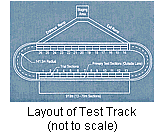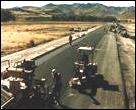
Performance Testing for Quality Roads Driverless trucks, their triple trailers in tow, drone through the sweltering days and frigid nights of western Nevada's high desert. They will travel steadily along their 2.9-km oval track at a constant 65 kph for up to 21 hours a day, 7 days a week, for 2 full years.
Information for Superior Road Building These driverless trucks, key participants in the Federal Highway Administration (FHWA)-sponsored WesTrack project, are doing more than just going around in circles. They are helping address the highest priority quality issue of the traveling public -- the condition of the pavement over which it travels every day. These driverless trucks, key participants in the Federal Highway Administration (FHWA)-sponsored WesTrack project, are doing more than just going around in circles. They are helping address the highest priority quality issue of the traveling public -- the condition of the pavement over which it travels every day.
A Quality- Driven ProjectThe technical information WesTrack is designed to yield through its research will benefit the professional highway community and its clients alike, from those who use city streets to those who travel the open highway, from the freight carrier to the automobile driver, from those who build streets and highways to those who maintain and administer them.WesTrack is about quality -- about the construction and performance of the roadway. It was conceived specifically to address two truly important quality-driven issues:
The Benefits of Quality WesTrack's aim is to improve upon the performance-related specifications that will direct and control future asphalt pavement construction. Doing so will mean tangible, real-world benefits in the form of longer-lasting pavements. WesTrack's aim is to improve upon the performance-related specifications that will direct and control future asphalt pavement construction. Doing so will mean tangible, real-world benefits in the form of longer-lasting pavements.
More durable pavement is like money in the bank. It makes for lower maintenance costs -- a huge issue for highway agencies -- and thus for more efficient use of public funds. It also helps meet the public's real desire for a smoother and safer ride, with the added benefit of reducing the delay and inconvenience that often accompany roadway maintenance.
WesTrack -- The Quest Continues
Over the years, FHWA has committed significant resources to the effort to develop longer-lasting pavements. The Superpave project was developed by the Strategic Highway Research Program (SHRP) to generate the tools (information, processes, tests, etc.) that engineers and contractors need to design more durable hot-mix asphalt roadways. SHRP met this daunting challenge, and, after 5 years of intensive research and testing, Superpave was introduced in 1992. When SHRP ended, FHWA followed up by establishing five Superpave Regional Centers that are now evaluating Superpave equipment and procedures, conducting original research, and providing Superpave system training. Today, the FHWA-sponsored WesTrack project is taking up the challenge of improving hot-mix asphalt construction by further developing performance-related specifications and by verifying Superpave mix design procedures. The importance of WesTrack can hardly be overstated: what is learned there will be an important resource for restoring, strengthening, and preserving the National Highway System.
Creating New Performance Specifications The test track has long been a valuable tool with which to evaluate highway materials and construction. Among the most important were six test track loops operated in the late 1950s by the American Association of State Highway Officials (AASHO). The AASHO Road Test helped establish standard design theories that were heavily utilized during the construction of the Interstate Highway System. The test track has long been a valuable tool with which to evaluate highway materials and construction. Among the most important were six test track loops operated in the late 1950s by the American Association of State Highway Officials (AASHO). The AASHO Road Test helped establish standard design theories that were heavily utilized during the construction of the Interstate Highway System.Today, WesTrack is carrying on that tradition with its mission to define a set of performance specifications for roads over which the nation will move in the 21st century. The program is already yielding valuable information. With the testing period less than a quarter complete, noticeable wear and deterioration have been observed in many of WesTrack's 26 test sections. These observations of early rutting and other wear associated problems, however, were expected by managers of the project -- the materials and the pavement cross-section were selected so that all 26 test segments will fail during the 2-year loading period. Further, only four of the sections were designed as high quality Superpave mixes; the other 22 were charted for early failure by varying the amounts of asphalt, the aggregate gradation, and the degree of compaction the pavement underwent during construction.
All of the test sections show some rutting due to the high summer temperatures at the test site, the makeup of the aggregate, and the heavy truck loading (the computer-controlled, driverless trucks hold their line so well that a limited amount of "wander" had to be programmed into their paths to better simulate real world conditions). There is no indication to date of any significant deformation in the base, the crushed stone layer beneath the hot-mix asphalt; rutting is due to failure of the hot-mix asphalt itself. The Road Ahead Over the course of the WesTrack's project's full 2-year lifetime, much additional information will be added to the interim findings above. Over the course of the WesTrack's project's full 2-year lifetime, much additional information will be added to the interim findings above.Whatever the nature of these forthcoming test results, they will contribute to the highway community's long-standing, diligent search for optimum HMA construction. As the next century approaches, the pursuit of more durable and cost-effective roadways remains vital to the economic and social life of the nation.
For More Information:
Co-Program Manager WesTrack Public Information Nevada Automotive Test Center Phone: (702) 629-2000 FAX: (702) 629-2029
Terry Mitchell WesTrack Home Page:Publications
(contains articles on WesTrack and test tracks in general)
Focus newsletter, December 1996
The Superpave System
The Superpave Regional Centers
|
 Even at this early stage of the project, WesTrack researchers have made a number of observations. The test sections that were initially built to less-than-optimum properties are performing as expected; a number exhibited severe rutting within a few months after loading. High asphalt content clearly had a negative impact on pavement performance (the five worst performing sections all had high amounts of asphalt). Several other sections, especially those with low asphalt content and high air voids, i.e., too little compaction, are beginning to show fatigue damage. This was also expected.
Even at this early stage of the project, WesTrack researchers have made a number of observations. The test sections that were initially built to less-than-optimum properties are performing as expected; a number exhibited severe rutting within a few months after loading. High asphalt content clearly had a negative impact on pavement performance (the five worst performing sections all had high amounts of asphalt). Several other sections, especially those with low asphalt content and high air voids, i.e., too little compaction, are beginning to show fatigue damage. This was also expected.